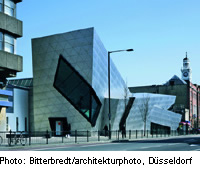A Critical View: Libeskind in London

Located in Holloway Road, north London, one of the busiest arterial routes in the city, the new Postgraduate Centre of the Metropolitan University required an iconic structure that would lend it a distinct identity in its desolate surroundings. Daniel Libeskind, the architect, has created a strikingly expressive sculpture consisting of “three intersecting shards”. The building resembles a piece of art in the public realm or a fortress encased in stainless-steel rather than a place of education. Fascinating though it is externally, the centre raises a number of questions. Hitherto, the “master of tragic memorials”, as the British press once called Libeskind, has designed forms symbolic of catastrophe and tragedy. For the Jewish Museum in Berlin, he used the image of the Star of David shattered by a stroke of lightning. For the Imperial War Museum in Manchester (2002), he opted for a similar aesthetic solution, taking the exploding globe as his model. In London, the form alone suffices. Libeskind claims to have chosen the constellation of Orion as his point of reference. His somewhat contrived argumentation, however, places him in the ranks of those architects who are intent on selling a brand image rather than a meaningful idea or individual solutions.
Any expectations of exciting or moving internal spaces aroused by the exterior are likely to be disappointed. Spatial atmosphere exists solely in the small lecture hall. The ground floor contains three uninspiring seminar rooms lined up along a dark corridor, while on the upper floor, the long, narrow cafeteria zone scarcely profits from the dramatically placed corner window. Like the exterior, though, this space is remarkably photogenic, and there is no lack of spectacular shots of the building. The marketing strategy would seem to bear fruit. That part of the assignment, at least, has been brilliantly fulfilled by the architect.
